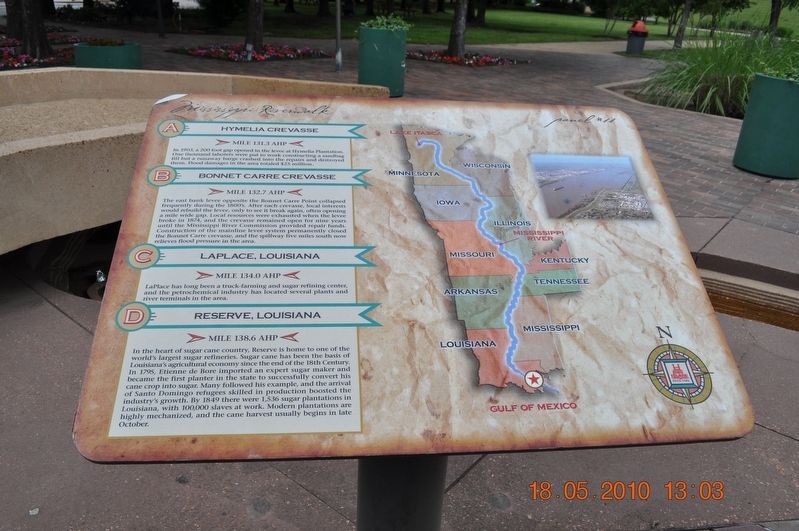Memphis in Shelby County, Tennessee — The American South (East South Central)
Hymelia Crevasse/Bonnet Carre Crevasse/Laplace, Louisiana/Reserve, Louisiana
Panel #11 Mississippi Riverwalk
Inscription.
A) Hymelia Crevasse
Mile 131.3 AHP
In 1903, a 200-foot gap opened in the levee at Hymelia Plantation. One thousand laborers were put to work constructing a sandbag fill but a runaway barge crashed into the repairs and destroyed them. Flood damages in the area totaled $25 million.
B) Bonnet Carre Crevasse
Mile 132.7 AHP
The east bank levee opposite the Bonnie Carre Point collapsed frequently during the 1800’s. After each crevasse, local interests would rebuild the levee, only to see it break again, often opening a mile wide gap. Lora resources were exhausted when the levee broke in 1874, and the crevasse remained open for nine years until the Mississippi River Commission provided repair funds. Construction of the mainline levee system permanently closed in Bonnet Carre crevasse, and the spillway five miles south now relieves flood pressure in the area.
C) Laplace, Louisiana
Mile 134.0 AHP
LaPLace has long been a truck-farming and sugar refining center, and the petrochemical industry has located several plants and river terminals in this area.
D) Reserve, Louisiana
Mile 138.6 AHP
In the heart of sugar cane country, Reserve is home to one of the world’s largest sugar refineries. Sugar cane has been the basis of Louisiana’s agricultural economy since the end of the 18th Century. In 1795, Etienne de Bore imported an expert sugar maker and became the first planter in the state to successfully concert his cane crop into sugar. Many followed his example, and the arrival of Santo Domingo refugees skilled in production boosted the industry’s growth. By 1849 there were 1,536 sugar plantations in Louisiana, with 100,000 slaves at work. Modern plantations are highly mechanized, and the cane harvest usually begins in late October.
Erected by Mississippi Riverwalk. (Marker Number 11.)
Topics. This historical marker is listed in these topic lists: African Americans • Disasters • Settlements & Settlers • Waterways & Vessels. A significant historical year for this entry is 1795.
Location. 35° 8.968′ N, 90° 3.507′ W. Marker is in Memphis, Tennessee, in Shelby County. Marker can be reached from Island Drive, 0.8 miles south of West A.W. Willis Avenue when traveling south. Located in Mud Island River Park. Touch for map. Marker is at or near this postal address: 125 N Front St, Memphis TN 38103, United States of America. Touch for directions.
Other nearby markers. At least 8 other markers are within walking distance of this marker. The Mississippi Riverwalk (here, next to this marker); Ohio River (here, next to this marker); Cairo, Illinois (here, next to this marker); Islands No. 2, 3, and 4 / Fort Jefferson, Kentucky / Bird’s Point, Missouri (here, next to this marker); Island No. 5 (Wolf Island)/Belmont, Missouri/Columbus, Kentucky (here, next to this marker); Donaldson Point, Missouri/Island No. 8/Hickman, Kentucky/Dorena Crevasse (here, next to this marker); New Madrid, Missouri/Cates Casting Field/Island No. 10 (here, next to this marker); Tiptonville, Tennessee/Bixby Towhead (here, next to this marker). Touch for a list and map of all markers in Memphis.
Also see . . .
1. Bonnet Carré Crevasse. Although the devastation to the Bonnet Carré area was great, its ecological impacts were somewhat beneficial.[3] By diverting river water and sediment, the crevasse saved a greater portion of land surrounding the area from succumbing to total flooding and land erosion.[3] Therefore, the crevasse served as a buffer for wetland erosion. Recognizing the benefits, the local government commissioned the construction of an artificial crevasse that could be periodically opened to drain excess water from the Mississippi.[3] (Submitted on March 12, 2018, by Sandra Hughes Tidwell of Killen, Alabama, USA.)
2. LaPlace, Louisiana. The Chitimacha lived in the region prior to the arrival of European colonists. The tribe’s lands once encompassed the entire Atchafalaya Basin, westward to Lafayette, Louisiana, southward to the Gulf of Mexico and eastward to the New Orleans area. The Chitimacha Tribe currently resides on a reservation in St. Mary Parish, Louisiana. (Submitted on March 12, 2018, by Sandra Hughes Tidwell of Killen, Alabama, USA.)
3. Reserve, Louisiana. In the early 20th century, the plantation at Reserve had the largest sugarcane refinery in the United States. President William Howard Taft visited Reserve in 1909, while President Gerald Ford visited Reserve in 1976. Reserve was the birthplace of jazz musicians Edmond Hall and Kid Thomas Valentine. (Submitted on March 12, 2018, by Sandra Hughes Tidwell of Killen, Alabama, USA.)
Credits. This page was last revised on August 27, 2020. It was originally submitted on March 12, 2018, by Sandra Hughes Tidwell of Killen, Alabama, USA. This page has been viewed 389 times since then and 43 times this year. Photo 1. submitted on March 12, 2018, by Sandra Hughes Tidwell of Killen, Alabama, USA. • Bernard Fisher was the editor who published this page.
Editor’s want-list for this marker. Wide shot of marker and its surroundings. • Can you help?
